Interrelationships between Urbanization and Ecosystem Services in the Urban Agglomeration around Poyang Lake and Its Zoning Management at an Integrated Multi-Scale
Abstract
:1. Introduction
2. Materials and Methods
2.1. Study Area
2.2. Data Sources and Processing
2.3. Methodological Framework
2.3.1. Measurement of Urbanization Level
2.3.2. Ecosystem Service Value
2.3.3. Correlation Analysis
2.3.4. Spatial Autocorrelation Analysis
2.3.5. Scale Selection Analysis
2.3.6. Spatial Regression Analysis
3. Results
3.1. Spatial-Temporal Evolution of Urbanization
3.2. Temporal and Spatial Changes in the ESV
3.3. Results of Correlation Analysis
3.4. Results of Spatial Autocorrelation Analysis
3.5. Results of Spatial Regression Analysis
3.6. Zoning Management of the Urban Agglomeration around Poyang Lake
4. Discussion
4.1. The Evolution of Urbanization and the ESV
4.2. The Interaction between Urbanization and the ESV
4.3. Policy Recommendations and Implications
5. Conclusions
- (1)
- From 2005 to 2020, the UL in the PYLUA has significantly increased, and the land urbanization has shifted from single-point expansion to multi-point expansion. The change in population density showed a steady growth and spread to the surrounding areas, and the gap in economic growth between regions was significantly reduced.
- (2)
- The ESV generally maintained a stable trend. The high-value areas were majorly situated around the Poyang Lake waters, and the low-value areas were majorly situated in urbanized areas with dense construction land.
- (3)
- Pearson’s correlation analysis revealed that the ESV and urbanization subsystems have shown a significant negative correlation over the past 15 years, regardless of the scale, and that population urbanization has more negative correlation with the ESV, while there is a certain degree of positive correlation between the urbanization subsystems.
- (4)
- There is a significant spatial negative correlation between the UL and ESV at all the scales in the PYLUA, and the negative effect is significantly enhanced over time. The distribution of H-H is sporadic and the least, and the distribution of L-L is wide. H-L is mainly distributed in economically developed areas such as the Great Nanchang metropolitan area in the southwest and the centers of counties and cities. L-H is mainly distributed in the central and eastern waters and woodland areas.
- (5)
- By adding a series of control variables, according to the OLS model regression results, land urbanization and population urbanization have a negative impact on their ESVs at the 1% significant level, and the impact of economic urbanization on the ESV is not significant. In the MGWR model regression results, land urbanization, population urbanization, and economic urbanization have better explanatory effects on the ESV at administrative scale and grid scale, respectively.
- (6)
- Through the study of the spatial interaction between urbanization and the ESV at different scales, the study area is divided into the Coordinated Development Zone, Co-Loss Zone, Development Lag Zone, Ecological Loss Zone, and Development Potential Zone. By analyzing the spatial effect of urbanization subsystem on the ESV, significant areas of negative effect in population urbanization, significant areas of negative effect in economic urbanization, significant areas of negative effect in land urbanization, and areas of more pronounced negative effect were identified. Ultimately, according to the situation of each zone, the corresponding management strategy is proposed.
- (7)
- It is proposed that certain pertinent measures be implemented in analogous geographic regions. First, land use should be planned to allow for different types of land use. Second, over-exploitation can be regulated through social supervision, public participation, and penalties. Third, policy should be made to break down administrative barriers.
Author Contributions
Funding
Institutional Review Board Statement
Informed Consent Statement
Data Availability Statement
Conflicts of Interest
References
- Fang, C. Important progress and prospects of China’s urbanization and urban agglomeration in the past 40 years of reform and opening-up. Econ. Geogr. 2018, 38, 1–9. [Google Scholar]
- Wu, Y.; Wu, Y.; Li, C.; Gao, B.; Zheng, K.; Wang, M.; Deng, Y.; Fan, X. Spatial relationships and impact effects between urbanization and ecosystem health in urban agglomerations along the Belt and Road: A case study of the Guangdong-Hong Kong-Macao Greater Bay Area. Int. J. Environ. Res. Public Health 2022, 19, 16053. [Google Scholar] [CrossRef] [PubMed]
- Chen, M.; Liu, W.; Tao, X. Evolution and assessment on China’s urbanization 1960–2010: Under-urbanization or over-urbanization? Habitat Int. 2013, 38, 25–33. [Google Scholar] [CrossRef]
- Navarro, M.; D’Agostino, A.; Neri, L. The effect of urbanization on subjective well-being: Explaining cross-regional differences. Socio-Econ. Plan. Sci. 2020, 71, 100824. [Google Scholar] [CrossRef]
- Sannigrahi, S.; Zhang, Q.; Joshi, P.K.; Sutton, P.C.; Keesstra, S.; Roy, P.S.; Pilla, F.; Basu, B.; Wang, Y.; Jha, S.; et al. Examining effects of climate change and land use dynamic on biophysical and economic values of ecosystem services of a natural reserve region. J. Clean. Prod. 2020, 257, 120424. [Google Scholar] [CrossRef]
- Hasan, S.S.; Zhen, L.; Miah, M.G.; Ahamed, T.; Samie, A. Impact of land use change on ecosystem services: A review. Environ. Dev. 2020, 34, 100527. [Google Scholar] [CrossRef]
- Wang, M.E.; Chen, W.P.; Peng, C. Urban ecological risk assessment: A review. Chin. J. Appl. Ecol. 2014, 25, 911–918. [Google Scholar]
- Ai, Z.; Yao, Y.; Dang, X.; Li, X.; Hou, M.; Deng, Y.; Xiao, L.; Li, T.; Wang, T. Study on the trade-off/synergy between ecosystem services and human well-being based on land use in Weinan City, China. Environ. Sci. Pollut. Res. 2024, 31, 13549–13562. [Google Scholar] [CrossRef] [PubMed]
- Wang, X.; Yao, W.; Luo, Q.; Yun, J. Spatial relationship between ecosystem health and urbanization in coastal mountain city, Qingdao, China. Ecol. Inform. 2024, 79, 102458. [Google Scholar] [CrossRef]
- Yang, M.; Gao, X.; Siddique, K.H.M.; Wu, P.; Zhao, X. Spatiotemporal exploration of ecosystem service, urbanization, and their interactive coercing relationship in the Yellow River Basin over the past 40 years. Sci. Total Environ. 2023, 858, 159757. [Google Scholar] [CrossRef]
- Chien, H.; Saito, O. Evaluating social–ecological fit in urban stream management: The role of governing institutions in sustainable urban ecosystem service provision. Ecosyst. Serv. 2021, 49, 101285. [Google Scholar] [CrossRef]
- Qiu, J.J.; Liu, Y.H.; Chen, C.J.; Huang, Q.Y. Spatial structure and driving pathways of the coupling between ecosystem services and human well-beings: A case study of Guangzhou. J. Nat. Resour. 2023, 38, 760–778. [Google Scholar]
- Yee, S.H.; Paulukonis, E.; Simmons, C.; Russell, M.; Fulford, R.; Harwell, L.; Smith, L.M. Projecting effects of land use change on human well-being through changes in ecosystem services. Ecol. Model. 2021, 440, 109358. [Google Scholar] [CrossRef] [PubMed]
- Yang, J.; Ma, X.; Zhao, X.; Li, W. Spatiotemporal of the coupling relationship between ecosystem services and human well-being in Guanzhong plain urban agglomeration. Int. J. Environ. Res. Public Health 2022, 19, 12535. [Google Scholar] [CrossRef]
- Wang, C.; Wang, X.; Wang, Y.; Zhan, J.; Chu, X.; Teng, Y.; Liu, W.; Wang, H. Spatio-temporal analysis of human wellbeing and its coupling relationship with ecosystem services in Shandong province, China. J. Geogr. Sci. 2023, 33, 392–412. [Google Scholar] [CrossRef]
- Zeng, C.; Cheng, Y.J.; Lyu, T.Y. Research on land-space ecological restoration zoning based on ecosystem health: Acase study of the urban agglomeration in the middle reaches along the Yangtze River. J. Nat. Resour. 2022, 37, 3118–3135. [Google Scholar] [CrossRef]
- Zhao, S.D.; Zhang, Y.M. Concepts, Contents and Challenges of Ecosystem Assessment—Introduction to “Ecosystems and Human Well-being: A Framework for Assessment”. Adv. Earth Sci. 2004, 19, 650–657. [Google Scholar]
- Costanza, R.; D’Arge, R.; De Groot, R.; Farber, S.; Grasso, M.; Hannon, B.; Limburg, K.; Naeem, S.; O’Neill, R.V.; Paruelo, J. The value of the world’s ecosystem services and natural capital. Nature 1997, 387, 253–260. [Google Scholar] [CrossRef]
- Chee, Y.E. An ecological perspective on the valuation of ecosystem services. Biol. Conserv. 2004, 120, 549–565. [Google Scholar] [CrossRef]
- Zhang, C.; Su, B.; Beckmann, M.; Volk, M. Emergy-based evaluation of ecosystem services: Progress and perspectives. Renew. Sustain. Energy Rev. 2024, 192, 114201. [Google Scholar] [CrossRef]
- Ouyang, Z.Y.; Wang, X.K.; Miao, H. Aprimary study on Chinese terrestrial ecosystem services and their ecological-economic values. Acta Ecol. Sin. 1999, 19, 607–613. [Google Scholar]
- Li, P.; Zhang, R.; Wei, H.; Xu, L. Assessment of physical quantity and value of natural capital in China since the 21st century based on a modified ecological footprint model. Sci. Total Environ. 2022, 806, 150676. [Google Scholar] [CrossRef] [PubMed]
- Xue, Z.; Meng, X.; Liu, B. Spatiotemporal evolution and driving factors of ecosystem services in the upper Fenhe watershed, China. Ecol. Indic. 2024, 160, 111803. [Google Scholar] [CrossRef]
- Xie, G.D.; Zhen, L.; Lu, C.X.; Xiao, Y.; Chen, C. Expert Knowledge Based Valuation Method of Ecosystem Services in China. J. Nat. Resour. 2008, 23, 911–919. [Google Scholar]
- Xie, G.D.; Zhang, C.X.; Zhang, L.M.; Chen, W.H.; Li, S.M. Improvement of the Evaluation Method for Ecosystem Service Value Based on Per Unit Area. J. Nat. Resour. 2015, 30, 1243–1254. [Google Scholar]
- Quan, L.A.; Jin, S.; Chen, J.; Li, T. Evolution and Driving Forces of Ecological Service Value in Anhui Based on Landsat Land Use and Land Cover Change. Remote Sens. 2024, 16, 269. [Google Scholar] [CrossRef]
- Wen, Y.L.; Zhang, X.L.; Wei, J.H.; Wang, X.L.; Cai, Y.J. Temporal and Spatial Variation of Ecosystem Service Value and Its Trade-offs and Synergies in the Peripheral Region of the Poyang Lake. Sci. Geogr. Sin. 2022, 42, 1229–1238. [Google Scholar]
- Wei, J.H.; Wen, Y.L.; Gong, Z.J.; Wang, X.L.; Cai, Y.J. Land use changes and ecosystem service value in the buffer zone of Poyang Lake in recent 30 years. Acta Ecol. Sin. 2022, 42, 9261–9273. [Google Scholar]
- Li, H.; de Jong, M. Citizen participation in China’s eco-city development. Will ‘new-type urbanization’ generate a breakthrough in realizing it? J. Clean. Prod. 2017, 162, 1085–1094. [Google Scholar] [CrossRef]
- Tu, D.; Cai, Y.; Liu, M. Coupling coordination analysis and spatiotemporal heterogeneity between ecosystem services and new-type urbanization: A case study of the Yangtze River Economic Belt in China. Ecol. Indic. 2023, 154, 110535. [Google Scholar] [CrossRef]
- Sato, Y.; Yamamoto, K. Population concentration, urbanization, and demographic transition. J. Urban Econ. 2005, 58, 45–61. [Google Scholar] [CrossRef]
- Zhou, L.; Tang, J.J.; Liu, X.K.; Dang, X.W.; Mu, H.W. Effects of urban expansion on habitat quality in densely populated areas on the Loess Pla-teau: A case study of Lanzhou, Xi’an-Xianyang and Taiyuan, China. Chin. J. Appl. Ecol. 2021, 32, 261–270. [Google Scholar]
- Jiao, L.; Mao, L.; Liu, Y. Multi-order Landscape Expansion Index: Characterizing urban expansion dynamics. Landsc. Urban Plan. 2015, 137, 30–39. [Google Scholar] [CrossRef]
- Chen, M.J.; Wang, Q.R.; Bai, Z.K.; Xie, L.J.; Zhang, B.S.; Hao, M. Land use transition of resource-based cities in the Yellow River Basin and its impact on ecosystem services. Acta Ecol. Sin. 2023, 43, 9459–9470. [Google Scholar]
- Chu, N.C.; Zhang, P.Y.; Li, H.; Li, X. Measurement and Spatial Differentiation of Urbanization Development in the Siberian and Far East Federal Districts in Russia. Sci. Geogr. Sin. 2018, 38, 1069–1078. [Google Scholar]
- Zhang, Q.; Seto, K.C. Mapping urbanization dynamics at regional and global scales using multi-temporal DMSP/OLS nighttime light data. Remote Sens. Environ. 2011, 115, 2320–2329. [Google Scholar] [CrossRef]
- Shen, J. The Measurement of Urban Concentration in China and the Study of Its Spatial Differentiation Characteristics: Based on DMSP-OLS Nighttime Light Data. Econ. Geogr. 2021, 41, 46–56. [Google Scholar]
- Li, S.; Liu, C.; Ge, C.; Yang, J.; Liang, Z.; Li, X.; Cao, X. Ecosystem health assessment using PSR model and obstacle factor diagnosis for Haizhou Bay, China. Ocean. Coast. Manag. 2024, 250, 107024. [Google Scholar] [CrossRef]
- Liu, Y.L.; Li, R.D.; Song, X.F. Grey Associative Analysis of Regional Urbanization and Eco-environment Coupling in China. Acta Geogr. Sin. 2005, 60, 237–247. [Google Scholar]
- Zhang, H.; Deng, W.; Zhang, S.; Peng, L.; Liu, Y. Impacts of urbanization on ecosystem services in the Chengdu-Chongqing Urban Agglomeration: Changes and trade-offs. Ecol. Indic. 2022, 139, 108920. [Google Scholar] [CrossRef]
- Grossman, G.M.; Krueger, A.B. Economic growth and the environment. Q. J. Econ. 1995, 110, 353–377. [Google Scholar] [CrossRef]
- Zhang, X.; Liu, Y.; Wang, Y.; Yuan, X. Interactive relationship and zoning management between county urbanization and ecosystem services in the Loess Plateau. Ecol. Indic. 2023, 156, 111021. [Google Scholar] [CrossRef]
- Zhang, J.T.; Jiao, W.X.; Han, B.L. Characteristics of coordination changes and spatial coupling relationship between urbanization and ecosystem services. Acta Ecol. Sin. 2020, 40, 3271–3282. [Google Scholar]
- Yang, C.; Zeng, W.; Yang, X. Coupling coordination evaluation and sustainable development pattern of geo-ecological environment and urbanization in Chongqing municipality, China. Sustain. Cities Soc. 2020, 61, 102271. [Google Scholar] [CrossRef]
- Deng, Z.B.; Zong, S.W.; Su, C.W.; Chen, Z. Research on Coupling Coordination Development between Ecological Civilization Construction and New Urbanization and Its Driving Forces in the Yangtze River Economic Zone. Econ. Geogr. 2019, 39, 78–86. [Google Scholar]
- Li, H.; Peng, J.; Yanxu, L.; Na, H.Y. Urbanization impact on landscape patterns in Beijing City, China: A spatial heterogeneity perspective. Ecol. Indic. 2017, 82, 50–60. [Google Scholar] [CrossRef]
- Wu, K.; Wang, D.; Lu, H.; Liu, G. Temporal and spatial heterogeneity of land use, urbanization, and ecosystem service value in China: A national-scale analysis. J. Clean. Prod. 2023, 418, 137911. [Google Scholar] [CrossRef]
- Liu, H.L.; Ding, Y.F.; Wang, Y.F.; Wang, W.Q.; Guo, X.J. Analysis of Temporal-spatial Correlation and Spatial Effect between Urbanization and Ecosystem Services in Shanxi Province. J. Soil Water Conserv. 2022, 36, 124–134. [Google Scholar]
- Chen, L.; Liu, Y.; Li, J.; Tian, P.; Zhang, H. Surface water changes in China’s Yangtze River Delta over the past forty years. Sustain. Cities Soc. 2023, 91, 104458. [Google Scholar] [CrossRef]
- Liu, C.; Liu, D.; Li, P.; Li, X.; Liu, Z.; Zhao, Y. Assessment of occupation of natural habitat by urban expansion and its impact on crucial ecosystem services in China’s coastal zone. Ecol. Indic. 2023, 154, 110682. [Google Scholar] [CrossRef]
- Chen, W.; Chi, G. Urbanization and ecosystem services: The multi-scale spatial spillover effects and spatial variations. Land Use Policy 2022, 114, 105964. [Google Scholar] [CrossRef]
- Fang, C.; Liu, H.; Wang, S. The coupling curve between urbanization and the eco-environment: China’s urban agglomeration as a case study. Ecol. Indic. 2021, 130, 108107. [Google Scholar] [CrossRef]
- Chen, W.; Wang, G.; Gu, T.; Fang, C.; Pan, S.; Zeng, J.; Wu, J. Simulating the impact of urban expansion on ecosystem services in Chinese urban agglomerations: A multi-scenario perspective. Environ. Impact Assess. Rev. 2023, 103, 107275. [Google Scholar] [CrossRef]
- Tian, P.; Liu, Y.; Li, J.; Pu, R.; Cao, L.; Zhang, H. Spatiotemporal patterns of urban expansion and trade-offs and synergies among ecosystem services in urban agglomerations of China. Ecol. Indic. 2023, 148, 110057. [Google Scholar] [CrossRef]
- Wang, S.J.; Kong, W.; Ren, L.; Zhi, D.D.; Dai, B.T. Research on misuses and modification of coupling coordination degree model in China. J. Nat. Resour. 2021, 36, 793–810. [Google Scholar] [CrossRef]
- Liu, G.L.; Zhang, L.C.; Zhang, Q. Spatial and temporal dynamics of land use and its influence on ecosystem service value in Yangtze River Delta. Acta Ecol. Sin. 2014, 34, 3311–3319. [Google Scholar]
- Mu, S.; Yang, G.; Xu, X.; Wan, R.; Li, B. Assessing the inundation dynamics and its impacts on habitat suitability in Poyang Lake based on integrating Landsat and MODIS observations. Sci. Total Environ. 2022, 834, 154936. [Google Scholar] [CrossRef] [PubMed]
- Li, J.; Xie, B.; Dong, H.; Zhou, K.; Zhang, X. The impact of urbanization on ecosystem services: Both time and space are important to identify driving forces. J. Environ. Manag. 2023, 347, 119161. [Google Scholar] [CrossRef] [PubMed]
- Ye, Y.; Bryan, B.A.; Connor, J.D.; Chen, L.; Qin, Z.; He, M. Changes in land-use and ecosystem services in the Guangzhou-Foshan Metropolitan Area, China from 1990 to 2010: Implications for sustainability under rapid urbanization. Ecol. Indic. 2018, 93, 930–941. [Google Scholar] [CrossRef]
- Ding, X.; Shu, Y.; Tang, X.; Ma, J. Identifying Driving Factors of Basin Ecosystem Service Value Based on Local Bivariate Spatial Correlation Patterns. Land 2022, 11, 1852. [Google Scholar] [CrossRef]
- Song, W.; Wang, C.; Chen, W.; Zhang, X.; Li, H.; Li, J. Unlocking the spatial heterogeneous relationship between per Capita GDP and nearby air quality using bivariate local indicator of spatial association. Resour. Conserv. Recycl. 2020, 160, 104880. [Google Scholar] [CrossRef]
- Lee, S. Developing a bivariate spatial association measure: An integration of Pearson’s r and Moran’s I. J. Geogr. Syst. 2001, 3, 369–385. [Google Scholar] [CrossRef]
- Anselin, L.; Syabri, I.; Smirnov, O. Visualizing multivariate spatial correlation with dynamically linked windows. In Proceedings of the CSISS Workshop on New Tools for Spatial Data Analysis, Santa Barbara, CA, USA, 10–11 May 2002; pp. 1–20. [Google Scholar]
- Xue, C.; Chen, X.; Xue, L.; Zhang, H.; Chen, J.; Li, D. Modeling the spatially heterogeneous relationships between tradeoffs and synergies among ecosystem services and potential drivers considering geographic scale in Bairin Left Banner, China. Sci. Total Environ. 2023, 855, 158834. [Google Scholar] [CrossRef] [PubMed]
- Hu, B.; Kang, F.; Han, H.; Cheng, X.; Li, Z. Exploring drivers of ecosystem services variation from a geospatial perspective: Insights from China’s Shanxi Province. Ecol. Indic. 2021, 131, 108188. [Google Scholar] [CrossRef]
- Tran, D.X.; Pearson, D.; Palmer, A.; Lowry, J.; Gray, D.; Dominati, E.J. Quantifying spatial non-stationarity in the relationship between landscape structure and the provision of ecosystem services: An example in the New Zealand hill country. Sci. Total Environ. 2022, 808, 152126. [Google Scholar] [CrossRef]
- Cheng, Y.; Kang, Q.; Liu, K.; Cui, P.; Zhao, K.; Li, J.; Ma, X.; Ni, Q. Impact of Urbanization on Ecosystem Service Value from the Perspective of Spatio-Temporal Heterogeneity: A Case Study from the Yellow River Basin. Land 2023, 12, 1301. [Google Scholar] [CrossRef]
- Ouyang, X.; Tang, L.; Wei, X.; Li, Y. Spatial interaction between urbanization and ecosystem services in Chinese urban agglomerations. Land Use Policy 2021, 109, 105587. [Google Scholar] [CrossRef]
- Zhang, Z.; Xia, F.; Yang, D.; Huo, J.; Wang, G.; Chen, H. Spatiotemporal characteristics in ecosystem service value and its interaction with human activities in Xinjiang, China. Ecol. Indic. 2020, 110, 105826. [Google Scholar] [CrossRef]
- Wen, Y.; Zhang, Z.; Liang, D.; Xu, Z. Rural residential land transition in the Beijing-Tianjin-Hebei region: Spatial-temporal patterns and policy implications. Land Use Policy 2020, 96, 104700. [Google Scholar] [CrossRef]
- Yushanjiang, A.; Zhou, W.; Wang, J.; Wang, J. Impact of urbanization on regional ecosystem services—A case study in Guangdong-Hong Kong-Macao Greater Bay Area. Ecol. Indic. 2024, 159, 111633. [Google Scholar]
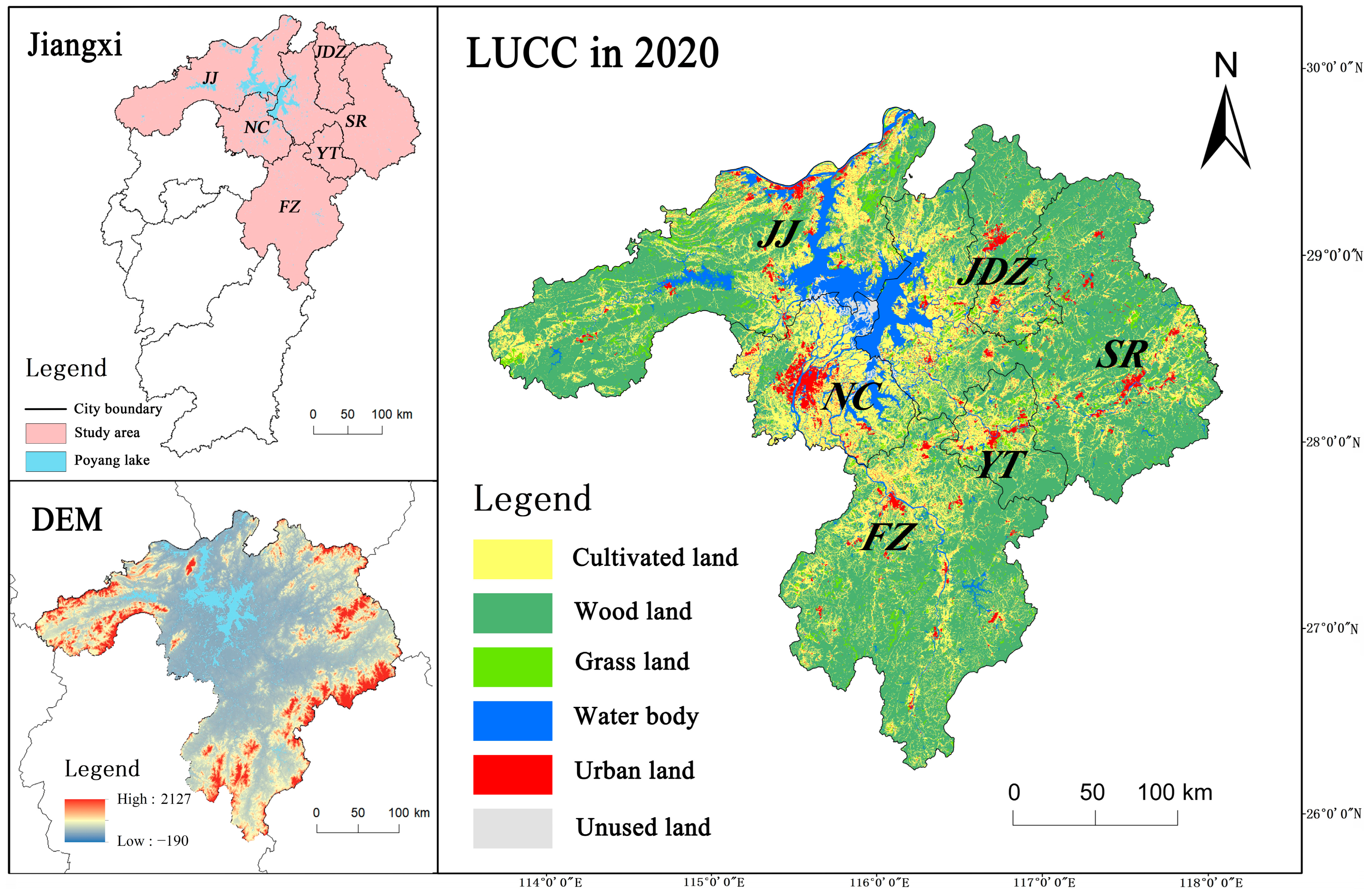
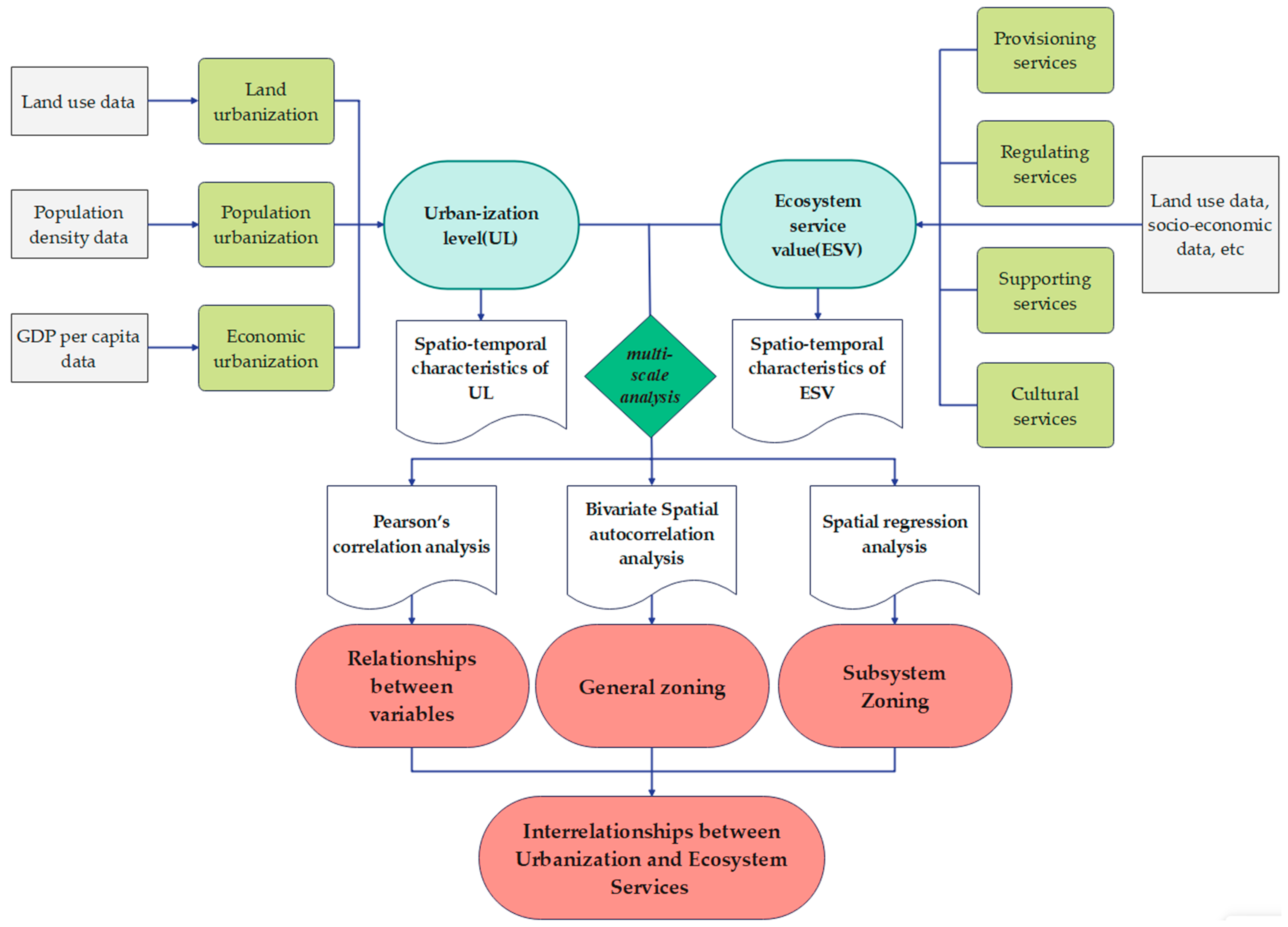



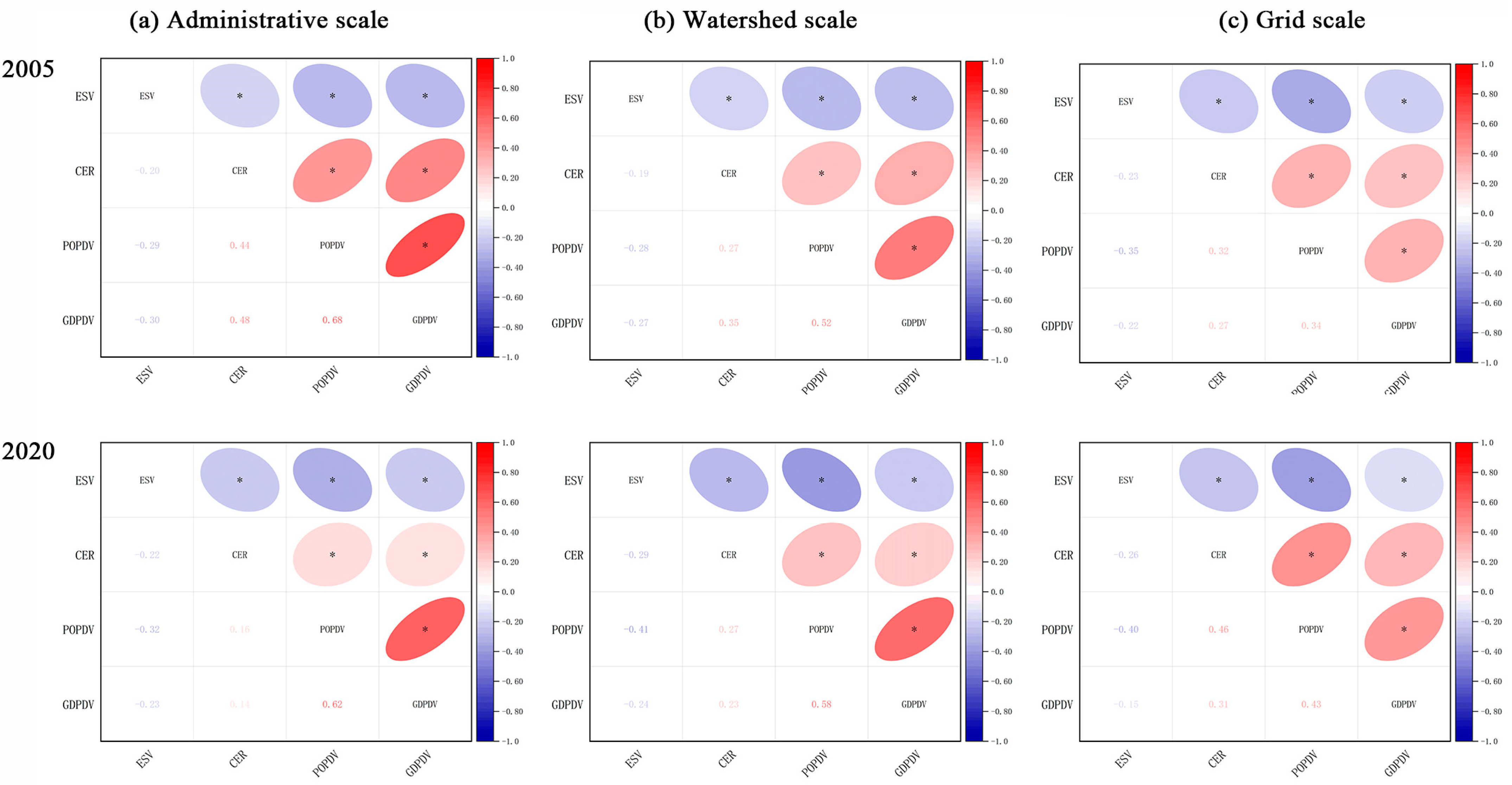

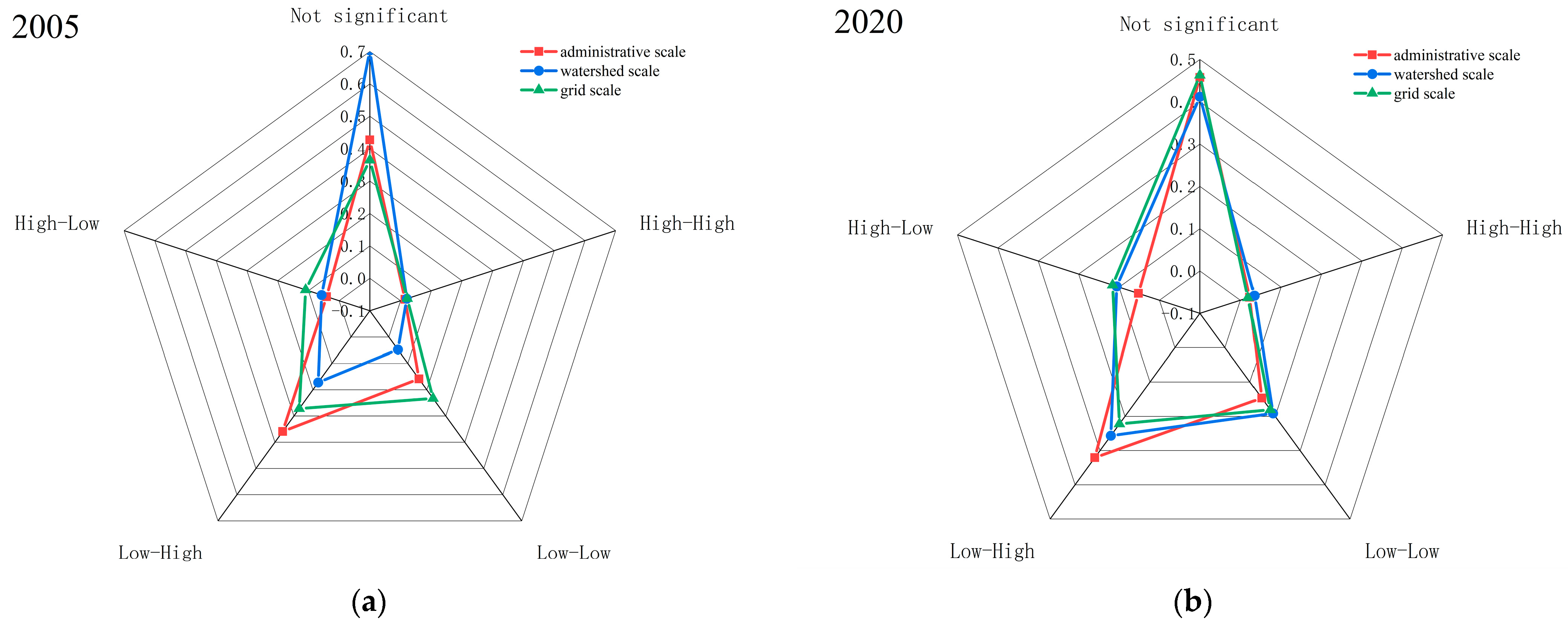


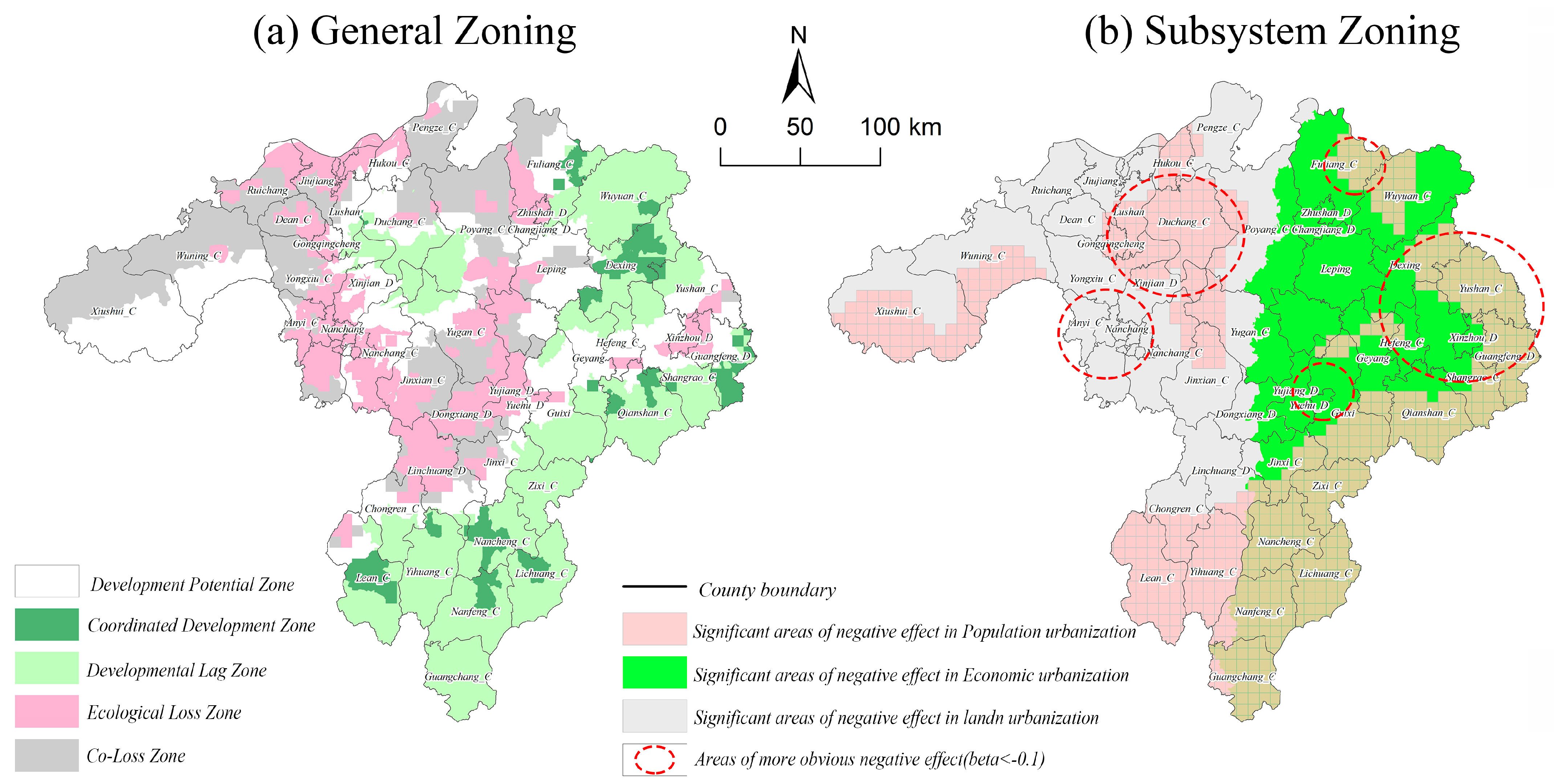
| First Classification | Secondary Classification | Cultivated Land | Wood Land | Grass Land | Water Body | Construction Land | Unused Land |
|---|---|---|---|---|---|---|---|
| Provisioning services | Food production | 2656.70 | 633.12 | 913.61 | 1574.78 | 0.00 | 0.00 |
| Raw material production | 589.04 | 1442.55 | 1346.38 | 877.55 | 0.00 | 0.00 | |
| Water supply | −3137.55 | 745.32 | 745.32 | 13,079.12 | 0.00 | 0.00 | |
| Regulating services | Gas regulation | 2139.78 | 4752.40 | 4736.37 | 3209.67 | 0.00 | 48.08 |
| Climate regulation | 1117.98 | 14,233.16 | 12,526.14 | 7080.51 | 0.00 | 0.00 | |
| Purification of the environment | 324.57 | 4167.37 | 4135.31 | 10,999.44 | 0.00 | 240.42 | |
| Hydrology | 3594.35 | 9296.43 | 9184.23 | 152,032.71 | 0.00 | 72.13 | |
| Supporting services | Soil conservation | 1250.21 | 5794.24 | 5770.20 | 3894.88 | 0.00 | 48.08 |
| Maintaining nutrient cycles | 372.66 | 440.78 | 432.76 | 300.53 | 0.00 | 0.00 | |
| Biodiversity | 408.72 | 5273.32 | 5241.26 | 12,526.14 | 0.00 | 48.08 | |
| Cultural services | Aesthetic landscape | 180.32 | 2316.09 | 2308.08 | 7958.07 | 0.00 | 24.04 |
| ESV | Nanchang | Jingdezhen | Jiujiang | Yingtan | Fuzhou | Shangrao | |
|---|---|---|---|---|---|---|---|
| 2005 | Provisioning services | 22.1167 | 12.0457 | 66.9917 | 7.6132 | 43.2684 | 65.9736 |
| Regulating services | 271.1167 | 145.0660 | 786.6882 | 93.6892 | 523.2290 | 784.4114 | |
| Support services | 42.2740 | 46.9354 | 174.0207 | 28.8698 | 168.3624 | 205.5660 | |
| Cultural services | 12.9465 | 9.5581 | 44.3364 | 5.9288 | 34.2925 | 47.1196 | |
| 2010 | Provisioning services | 21.4149 | 11.9984 | 68.5532 | 7.5867 | 43.4159 | 65.6020 |
| Regulating services | 263.5089 | 803.8165 | 803.8165 | 93.3243 | 524.8049 | 780.3705 | |
| Support services | 41.3243 | 28.6038 | 175.2411 | 28.6038 | 167.9769 | 204.3301 | |
| Cultural services | 12.5662 | 34.3153 | 45.0963 | 5.8932 | 34.3153 | 46.8493 | |
| 2015 | Provisioning services | 21.4118 | 11.9696 | 68.5645 | 7.5394 | 43.3637 | 65.4673 |
| Regulating services | 263.1805 | 144.2731 | 803.4206 | 92.7221 | 524.0308 | 778.6550 | |
| Support services | 41.1230 | 46.4811 | 174.7965 | 28.4072 | 167.6864 | 203.8037 | |
| Cultural services | 12.5476 | 9.4877 | 45.0614 | 5.8552 | 34.2669 | 46.7436 | |
| 2020 | Provisioning services | 21.4946 | 11.9126 | 68.4847 | 7.5083 | 43.2818 | 65.3029 |
| Regulating services | 263.5514 | 143.4800 | 801.9979 | 92.2261 | 522.7648 | 776.4433 | |
| Support services | 40.8155 | 46.1822 | 174.2684 | 28.1918 | 167.2288 | 202.9100 | |
| Cultural services | 12.5556 | 9.4341 | 44.9796 | 5.8217 | 34.1855 | 46.5889 | |
| OLS | Administrative Scale | Watershed Scale | Grid Scale |
|---|---|---|---|
| CER | −0.080 ** | −0.165 ** | −0.153 ** |
| (−3.68) | (−4.69) | (−5.69) | |
| POPDV | −0.258 ** | −1.326 ** | −1.643 ** |
| (−2.62) | (−5.46) | (−10.98) | |
| GDPDV | −0.072 | 0.019 | −0.065 |
| (−1.50) | −0.230 | (−1.17) | |
| C1 | 0.000 | 0.000 | 0.000 |
| −1.570 | −1.280 | −0.910 | |
| C2 | 0.001 ** | 0.000 ** | 0.000 ** |
| −12.150 | −3.280 | −10.970 | |
| C3 | −0.000 ** | −0.000 ** | −0.000 ** |
| (−5.25) | (−3.20) | (−5.48) | |
| C4 | −0.001 | 0.008 ** | 0.009 ** |
| (−0.57) | −2.200 | −3.500 | |
| C5 | 0.034 ** | 0.060 ** | 0.013 ** |
| −4.480 | −5.460 | −2.810 | |
| Constant | 0.239 ** | 0.388 ** | 0.480 ** |
| −6.620 | −5.190 | −9.160 | |
| N | 875 | 545 | 1749 |
| R2 | 0.374 | 0.314 | 0.280 |
| Adj.R2 | 0.368 | 0.303 | 0.277 |
| F | 64.620 | 28.490 | 87.810 |
| MGWR | Administrative Scale | Watershed Scale | Grid Scale | |
|---|---|---|---|---|
| CER | Min | −0.048 * | −0.069 * | −0.041 ** |
| Median | −0.016 | −0.038 | −0.039 ** | |
| Max | 0.019 | 0.025 ** | −0.039 ** | |
| POPDV | Min | −0.638 ** | −0.537 ** | −0.674 ** |
| Median | −0.053 | −0.144 | −0.104 | |
| Max | 0.638 ** | 0.569 ** | 0.175 * | |
| GDPDV | Min | −0.087 ** | −0.048 | −1.308 ** |
| Median | −0.038 | −0.021 | −0.113 | |
| Max | −0.021 | 0.101 ** | 0.877 ** | |
| AIC | 670.381 | 486.36 | 746.067 | |
| AICc | 787.808 | 535.027 | 1032.834 | |
| R2 | 0.920 | 0.902 | 0.945 | |
| Adj.R2 | 0.897 | 0.897 | 0.927 | |
Disclaimer/Publisher’s Note: The statements, opinions and data contained in all publications are solely those of the individual author(s) and contributor(s) and not of MDPI and/or the editor(s). MDPI and/or the editor(s) disclaim responsibility for any injury to people or property resulting from any ideas, methods, instructions or products referred to in the content. |
© 2024 by the authors. Licensee MDPI, Basel, Switzerland. This article is an open access article distributed under the terms and conditions of the Creative Commons Attribution (CC BY) license (https://creativecommons.org/licenses/by/4.0/).
Share and Cite
Luo, Z.; Yang, X. Interrelationships between Urbanization and Ecosystem Services in the Urban Agglomeration around Poyang Lake and Its Zoning Management at an Integrated Multi-Scale. Sustainability 2024, 16, 5128. https://doi.org/10.3390/su16125128
Luo Z, Yang X. Interrelationships between Urbanization and Ecosystem Services in the Urban Agglomeration around Poyang Lake and Its Zoning Management at an Integrated Multi-Scale. Sustainability. 2024; 16(12):5128. https://doi.org/10.3390/su16125128
Chicago/Turabian StyleLuo, Zhijun, and Xiaofang Yang. 2024. "Interrelationships between Urbanization and Ecosystem Services in the Urban Agglomeration around Poyang Lake and Its Zoning Management at an Integrated Multi-Scale" Sustainability 16, no. 12: 5128. https://doi.org/10.3390/su16125128






